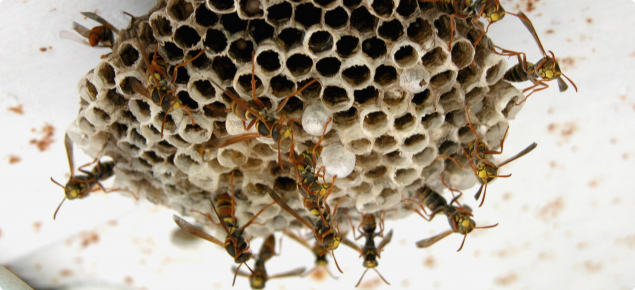Paper wasps are social insects belonging to the Vespidae family. These wasps live in colonies consisting of workers, queens and males. Their papery, honeycomb celled nests are a distinguishing feature for these wasps.
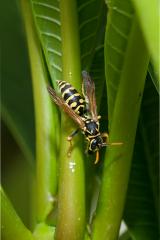 | Yellow paper wasp, Polistes dominulus, also known as European paper wasp - is an introduced species to Australia. It was first discovered in WA in 1986, and is now prevalent throughout the south west of the state.
The yellow paper wasp can be confused with the European wasp but their nesting habits and behaviour is quite different.
|
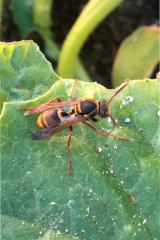 | Common paper wasp, Polistes humilis, is native to eastern Australia and established in WA around 1956.
|
Paper wasps make their nests from plant and wood fibres which they chew and mix with saliva into a 'paper mache'-like consistency. The final product is a grey papery nest of many cells in a single comb. The nest has the shape of a cone or crumpet, ranging in size from a golf ball to a dinner plate but are more commonly the size of the palm of your hand. They are fixed in place by a single attachment point.
Paper wasp queens start building new nests early in spring and continue through summer and autumn. New wasps develop and take over the major duties of food collection, caring for the young, nest maintenance and defense. The colony dies out in late autumn and the new mated queens disband, leaving the nest to find shelter in protected places (such as hollow trees, wall voids) to hibernate.
Adults feed on plant nectar and insect honeydew and forage for caterpillars and other insects (including beneficial insects) to feed their developing young.
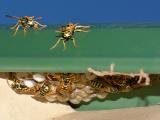 | 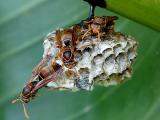 |  |
| Yellow paper wasp nest under fence capping | Common paper wasp nest under leave | Paper wasp nest in swing set structure |
Well adapted to urban environments, paper wasps commonly nest under fence capping, under eaves and roof tiles, attached to walls and bushes or in metal tubing or pipe work such as that of gates, clothes lines or play equipment. Letter boxes are also common nesting locations for these species.
Paper wasps will often attack if they feel threatened or their nests are disturbed. They can deliver painful stings and unlike honey bees, paper wasps can sting repeatedly.
Control
Nests can be treated by either the householder or a pest control operator. If the nest is not visible, watch where the foraging wasps fly to, or check eaves, walls, shutters and fence capping around your property.
Nests left untreated will produce more queens that can lead to an increase in paper wasp populations the following year
To control:
- Locate the nest(s) - there may be more than one in close proximity.
- After dark, or before sunrise, spray the nest with a fast knock-down fly spray or surface spray. This is the safest time to treat nests and ensures that all wasps belonging to the nest are present and not out foraging.
- The following day, knock the nest(s) to the ground and dispose of dead wasps and nest (crushing the nest will kill the pupating wasps in the white capped cells).
NOTE:
- Continued wasp activity in the same area indicates the presence of additional nest(s).
- Where nests are hidden inside pipework (such as swing sets, washing line poles or gates), spray into the holes as best you can. Spray every a few days over two weeks or block the hole if it's not needed for drainage.
Sting first aid
For information on treatment of wasp stings, please visit the Australian Health Direct website or contact the Western Australian Poisons Information Centre on 13 11 26.

